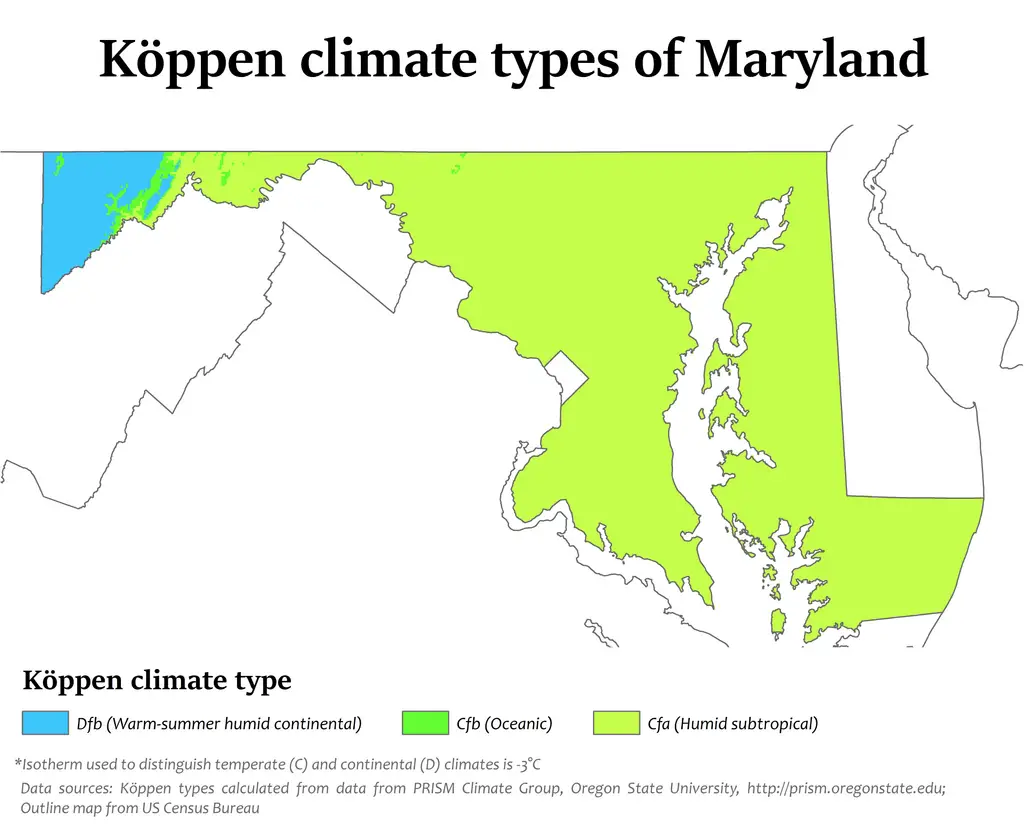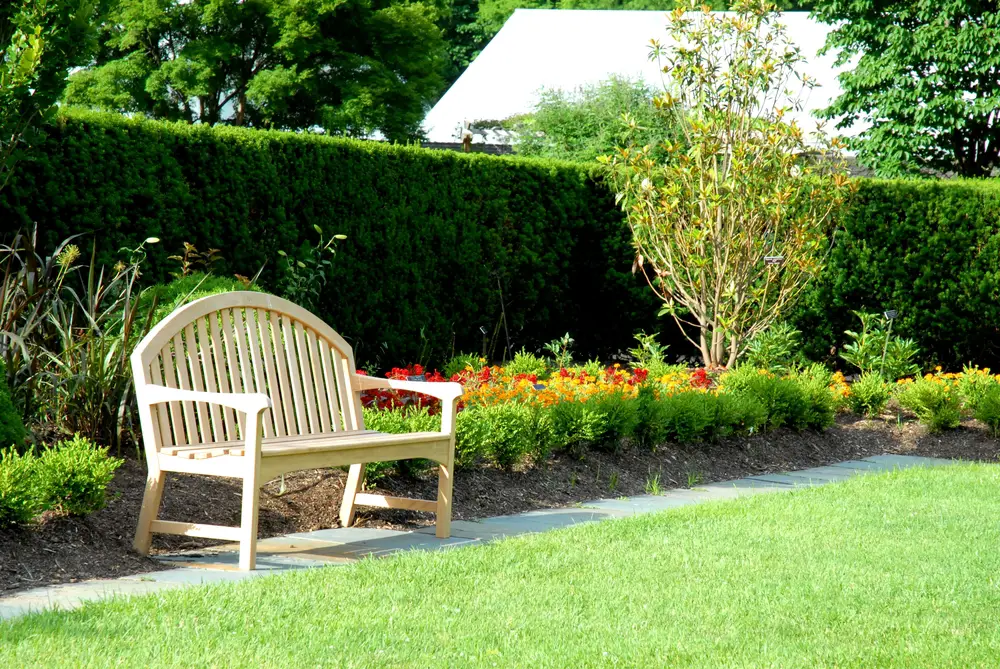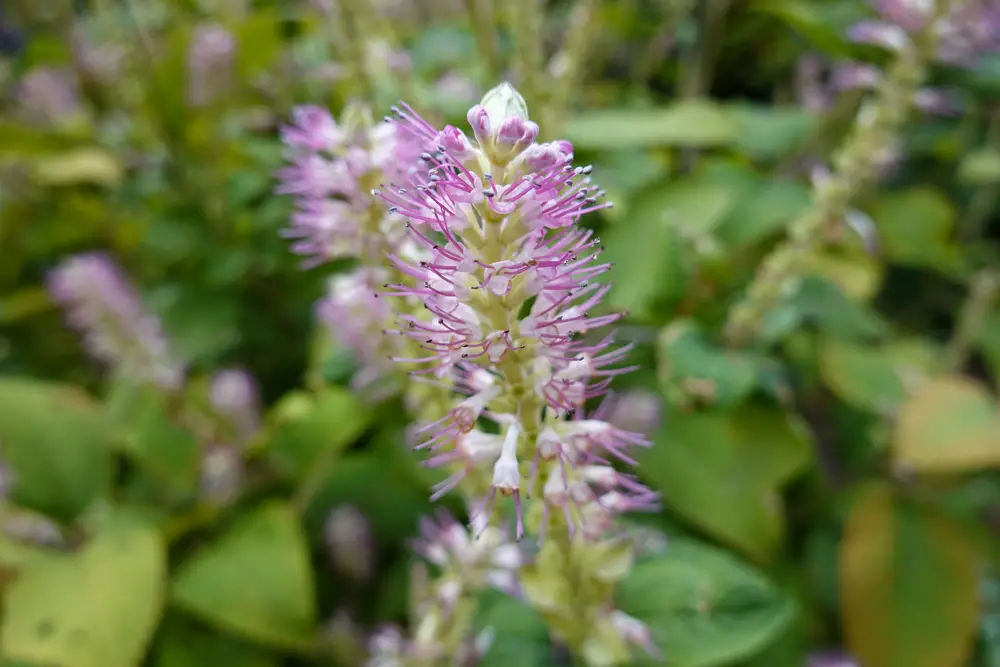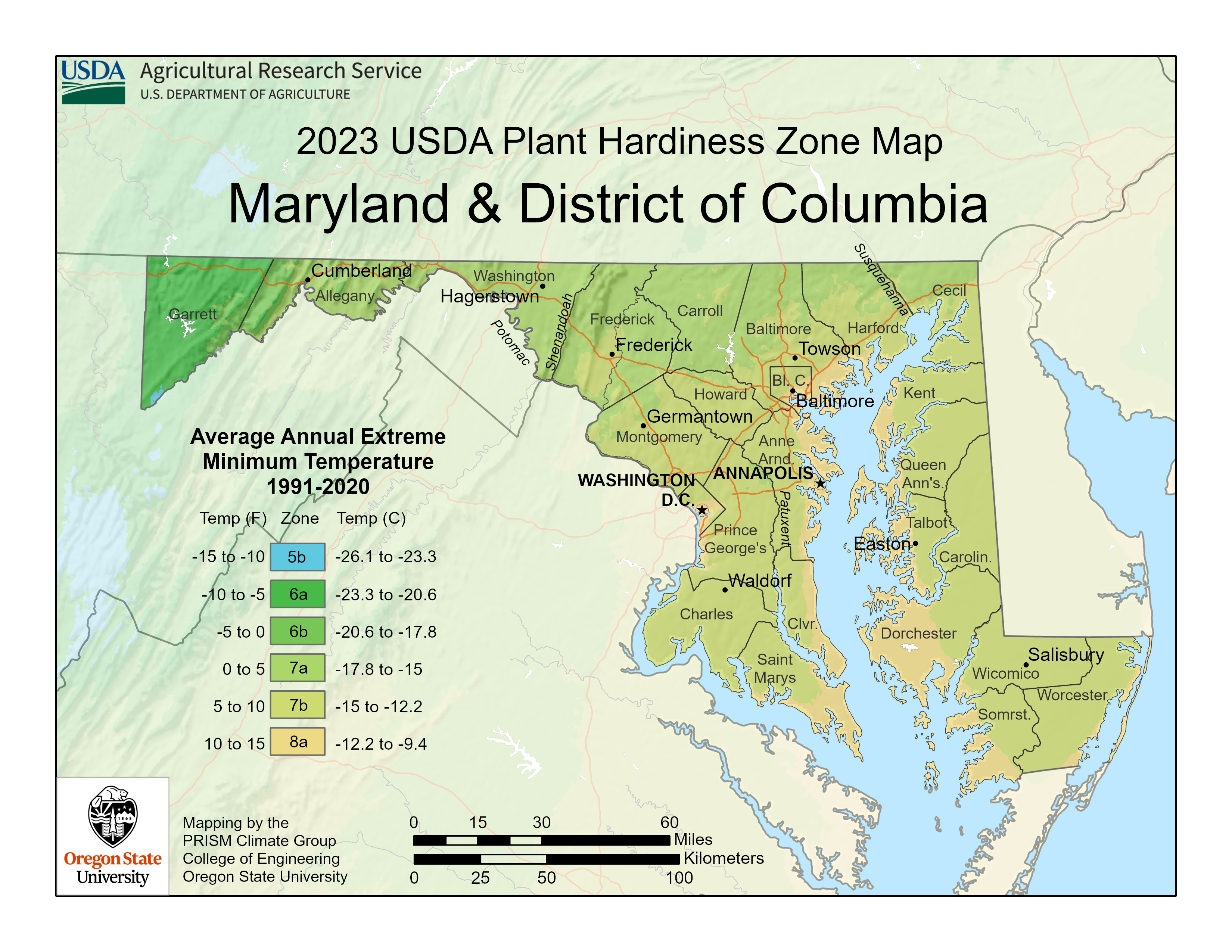Maryland Plant Hardiness Zones
| USDA Hardiness Zone | Average Minimum Extreme Winter Temperature Range Fahrenheit (°F) Celsius (°C) | Average Last Frost Date Range In Spring (Beginning Of The Growing Season) | Average First Frost Date Range In Autumn (End Of The Growing Season) |
|---|---|---|---|
| 5b | -15°F to -10°F -26.1°C to – 23.3°C | Early to mid-May | Late September to early October |
| 6a | -10°F to -5°F -23.3°C to 20.6°C | Late April to early May | Early to mid-October |
| 6b | -5°F to 0°F -20.6°C to 17.8°C | Late April to early May | Early to mid-October |
| 7a | 0°F to 5°F -17.8°C to -15°C | Late April to early May | Early to mid-October |
| 7b | 5°F to 10°F -15°C to -12.2°C | Early April to mid-April | Late October to early November |
| 8a | 10°F to 15°F -12.2°C to -9.4°C | Late March to early April | Early to mid-November |
Maryland Growing Conditions
General Climate

Maryland is divided into two climate regions.
The first is a warm-summer humid continental climate, found in the higher elevations in the west.
It is affected by the wind from the northwest and experiences moderately cold winters with occasional snow. The summers are appropriately warm and humid.
Most of the state has a humid subtropical climate. The humid subtropical climate is moist and warm in the summer, with lots of precipitation and high humidity. Winters are moderate and can experience frost, occasional snow, and nor’easters.
A small portion feels the effects of an oceanic climate due to its proximity to the Chesapeake Bay and Atlantic Ocean.
The Chesapeake Bay, which divides the state in the eastern quadrant, is more than 64,000 square miles of watershed and one of the most productive estuaries in the world. This has a massive effect on the weather and overall climate near the coast.
Microclimates
USDA plant hardiness zones are an important starting point for your garden, but you’ll also need to consider microclimates.
Microclimates are areas where specific conditions create a climate different from the climate they’re situated in.
Buildings, fences, paved areas, or short hills and valleys can create these microclimates.
They can be as small as a space in your backyard or as large as a city.
In other words, learn about your local conditions from local experts to see if your garden falls into a microclimate.
Extreme Weather
Unpredictable Weather
Situated right in the middle of the East Coast, Maryland’s geography plays a large factor in its unpredictable weather patterns. Winds from all directions significantly affect the weather you’ll experience.
The state is small in size but has a wide range of hardiness zones and climates.
Maryland is a mountainous region with elevation gain and also experiences the Maritime effects of The Chesapeake Bay. Combined, these weather patterns impact the state and make weather relatively unpredictable, more commonly in the fall and winter.
July through August can see an average of 1 thunderstorm every 5 days, bringing rain, wind, and even feel the effects of distant hurricanes. Tornadoes can affect some areas in Maryland from May through July, averaging around 3 a year.
Gardening in unpredictable weather is never easy. Keep coverings for various sizes of shrubs, like burlap, on hand in case of extreme weather. Also, maintain your trees. Removing deadwood prevents it from breaking off and damaging property during storms.
Growing Season
Maryland’s growing season has quite a bit of range, depending on where you are in the state.
The interior experiences around 130 days of growing, which is considered quite low.
The south of Maryland and the lower Eastern Shore can experience upwards of 230 days of freeze-free weather. This is due to elevation gain, wind patterns, and proximity to the coast.
Maryland Gardening Tips

Plant For The Birds
Maryland is known for its abundance of bird species and is considered a birders’ paradise! Birds are important in the garden as they aid in seed dispersal, balance insect populations, and contribute to a healthy ecosystem.
The Chesapeake Bay waterways and estuaries bring in many species of birds, from shore and aquatic birds to various garden and song birds. Try growing native plants to draw in some!
Native plants have formed a symbiotic relationship with native birds and other pollinators that has been evolving for over a millennia. Planting for birds can be a fun way to create abundant ecosystems. It also helps engage and educate children on the importance of native wildlife and habitat.
By providing food, foraging, and nesting habitat for birds, you can help build populations that may be in decline. Habitat features like bird boxes are a great way to create a nesting habitat. Make sure to do your research, as different birds require different-sized nesting boxes.
Letting flowers go to seed, like cosmos or echinacea, provides a food source for seed-eating birds. Planting fruiting trees and shrubs does as well.
Have a specific bird you love? Look up its food source and try adding it to your garden.
Attract Beneficial Insects
Attracting beneficial insects can help aid in pollination, creating stronger, more fruitful crops, can be a form of biological pest control, and can create buzzing biodiversity for future generations to come.
Many insect species are in decline due to herbicides and other chemical applications, as well as habitat loss from urbanization and agriculture.
One awesome beneficial insect that calls Maryland home is the firefly. This bug belongs to the beetle family. 6 different species of fireflies reside in Maryland!
Why so awesome?
Fireflies are beneficial pollinators of flowers and veggies. They are also a form of biological pest management. This is with garden pests like snails and slugs when they are in their larvae life phase.
To attract fireflies to your garden, plant native grasses for them to perch on. They use them to signal potential mates. This is a beautiful experience to witness and a fun way to teach children how cool bugs can be!
Fireflies require trees to deposit their eggs and prefer species of pine. Try adding rotting logs as a natural habitat feature to attract food sources for their larvae.
Large pieces of wood can be discrete and non-smelling. You can artistically place them in your garden, creating more of an organic look. As these logs break down, they add nutrients to your garden that your plants can thrive on. These logs host beneficial fungi, insects and microbes that create healthy ecosystems.
Consult With Local Professionals
Consulting with local gardening professionals allows you to benefit from their experience with your area’s conditions, the plants that do well there, and overall best practices.
Maryland Plant Suggestions

Trees
- Sweetbay Magnolia (Magnolia virginiana)
- Tulip Poplar (Liriodendron tulipifera)
- White Ash (Fraxinus americana)
Shrubs
- Summersweet (Clethra alnifolia)
- Common Witch Hazel (Hamamelis virginiana)
- Smooth Hydrangea (Hydrangea arborescens)
Flowers
- Foxglove beardtongue (Penstemon digitalis)
- Cardinal flower (Lobelia cardinalis)
- Turk’s Cap Lily (Lilium superbum)
Vegetables
- Jalapeños Peppers (Capsicum annuum)
- Cucumbers (Cucumis sativus)
- Zucchini (Cucurbita pepo)
Herbs
- Mint (Mentha)
- Rosemary (Rosmarinus officinalis)
- Chives (Allium schoenoprasum)
Spices
- Thyme (Thymus vulgaris L.)
- Sage (Salvia officinalis)
- Lavender (Lavandula)
Fruits
- Black Cherry (Prunus serotina)
- Paw Paws (Asimina triloba)
- Persimmons (Diospyros)
Succulents
- Allegheny stonecrop (Hylotelephium telephioides)
- Eastern prickly pear (Opuntia humifusa)
- Showy Stonecrop ‘Autumn Joy’ (Sedum spectabile)
Disclaimer
Any of the above can change and is not exhaustive.
Treat anything above like a good starter guide. Then use that as a foundation as you consult with local gardeners, professionals, forecasts, guides, and organizations.

